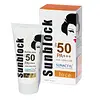What's inside
What's inside
 Key Ingredients
Key Ingredients

 Benefits
Benefits

 Concerns
Concerns

 Ingredients Side-by-side
Ingredients Side-by-side

Water
Skin ConditioningEthylhexyl Methoxycinnamate
UV AbsorberPropylheptyl Caprylate
EmollientGlyceryl Stearate
EmollientCeteareth-20
CleansingCeteareth-12
EmulsifyingCetearyl Alcohol
EmollientCetyl Palmitate
EmollientDiethylamino Hydroxybenzoyl Hexyl Benzoate
UV FilterCetyl Alcohol
EmollientZinc Oxide
Cosmetic ColorantHydrogen Dimethicone
Mannitol
HumectantCarrageenan
Xanthan Gum
EmulsifyingLaminaria Digitata Extract
Skin ProtectingPisum Sativum Extract
Skin ConditioningHistidine Hcl
Skin ConditioningArginine
MaskingCyclodextrin
AbsorbentDextrin
AbsorbentYeast Extract
Skin ConditioningAcetyl Tyrosine
Skin ConditioningPyridoxine Hcl
Skin ConditioningKhaya Senegalensis Bark Extract
Skin ProtectingNicotinamide Adenine Dinucleotide
Skin ConditioningDisodium Succinate
MaskingAspartic Acid
MaskingButyl Methoxydibenzoylmethane
UV AbsorberMethylene Bis-Benzotriazolyl Tetramethylbutylphenol
UV FilterBenzophenone-3
UV AbsorberTitanium Dioxide
Cosmetic ColorantSilicon
AbrasiveDimethicone/Methicone Copolymer
Cocoglycerides
EmollientDimethicone
EmollientButyrospermum Parkii Butter
Skin ConditioningPentaerythrityl Distearate
EmulsifyingHydrogenated Dimer Dilinoleyl/Dimethylcarbonate Copolymer
Emulsion StabilisingOctocrylene
UV AbsorberTocopheryl Acetate
AntioxidantCaprylyl Glycol
EmollientMethylisothiazolinone
PreservativeChlorphenesin
AntimicrobialSodium Polyacrylate
AbsorbentParfum
MaskingDipotassium Glycyrrhizate
HumectantTetrasodium EDTA
Water, Ethylhexyl Methoxycinnamate, Propylheptyl Caprylate, Glyceryl Stearate, Ceteareth-20, Ceteareth-12, Cetearyl Alcohol, Cetyl Palmitate, Diethylamino Hydroxybenzoyl Hexyl Benzoate, Cetyl Alcohol, Zinc Oxide, Hydrogen Dimethicone, Mannitol, Carrageenan, Xanthan Gum, Laminaria Digitata Extract, Pisum Sativum Extract, Histidine Hcl, Arginine, Cyclodextrin, Dextrin, Yeast Extract, Acetyl Tyrosine, Pyridoxine Hcl, Khaya Senegalensis Bark Extract, Nicotinamide Adenine Dinucleotide, Disodium Succinate, Aspartic Acid, Butyl Methoxydibenzoylmethane, Methylene Bis-Benzotriazolyl Tetramethylbutylphenol, Benzophenone-3, Titanium Dioxide, Silicon, Dimethicone/Methicone Copolymer, Cocoglycerides, Dimethicone, Butyrospermum Parkii Butter, Pentaerythrityl Distearate, Hydrogenated Dimer Dilinoleyl/Dimethylcarbonate Copolymer, Octocrylene, Tocopheryl Acetate, Caprylyl Glycol, Methylisothiazolinone, Chlorphenesin, Sodium Polyacrylate, Parfum, Dipotassium Glycyrrhizate, Tetrasodium EDTA
Cocos Nucifera Oil
MaskingWater
Skin ConditioningSodium Hydroxide
BufferingParfum
MaskingKojic Acid
AntioxidantGlycerin
HumectantXanthan Gum
EmulsifyingCaprylyl Glycol
EmollientGlucose
HumectantChondrus Crispus
MaskingPhenoxyethanol
PreservativeEthylhexylglycerin
Skin ConditioningCocamide DEA
EmulsifyingParaffinum Liquidum
EmollientMelaleuca Alternifolia Leaf Oil
AntioxidantCI 15985
Cosmetic ColorantCI 19140
Cosmetic ColorantBHT
Antioxidant
 Reviews
Reviews

Ingredients Explained
These ingredients are found in both products.
Ingredients higher up in an ingredient list are typically present in a larger amount.
Caprylyl Glycol is a humectant and emollient, meaning it attracts and preserves moisture.
It is a common ingredient in many products, especially those designed to hydrate skin. The primary benefits are retaining moisture, skin softening, and promoting a healthy skin barrier.
Though Caprylyl Glycol is an alcohol derived from fatty acids, it is not the kind that can dry out skin.
This ingredient is also used as a preservative to extend the life of products. It has slight antimicrobial properties.
Learn more about Caprylyl GlycolParfum is a catch-all term for an ingredient or more that is used to give a scent to products.
Also called "fragrance", this ingredient can be a blend of hundreds of chemicals or plant oils. This means every product with "fragrance" or "parfum" in the ingredients list is a different mixture.
For instance, Habanolide is a proprietary trade name for a specific aroma chemical. When used as a fragrance ingredient in cosmetics, most aroma chemicals fall under the broad labeling category of “FRAGRANCE” or “PARFUM” according to EU and US regulations.
The term 'parfum' or 'fragrance' is not regulated in many countries. In many cases, it is up to the brand to define this term.
For instance, many brands choose to label themselves as "fragrance-free" because they are not using synthetic fragrances. However, their products may still contain ingredients such as essential oils that are considered a fragrance by INCI standards.
One example is Calendula flower extract. Calendula is an essential oil that still imparts a scent or 'fragrance'.
Depending on the blend, the ingredients in the mixture can cause allergies and sensitivities on the skin. Some ingredients that are known EU allergens include linalool and citronellol.
Parfum can also be used to mask or cover an unpleasant scent.
The bottom line is: not all fragrances/parfum/ingredients are created equally. If you are worried about fragrances, we recommend taking a closer look at an ingredient. And of course, we always recommend speaking with a professional.
Learn more about ParfumWater. It's the most common cosmetic ingredient of all. You'll usually see it at the top of ingredient lists, meaning that it makes up the largest part of the product.
So why is it so popular? Water most often acts as a solvent - this means that it helps dissolve other ingredients into the formulation.
You'll also recognize water as that liquid we all need to stay alive. If you see this, drink a glass of water. Stay hydrated!
Learn more about WaterXanthan gum is used as a stabilizer and thickener within cosmetic products. It helps give products a sticky, thick feeling - preventing them from being too runny.
On the technical side of things, xanthan gum is a polysaccharide - a combination consisting of multiple sugar molecules bonded together.
Xanthan gum is a pretty common and great ingredient. It is a natural, non-toxic, non-irritating ingredient that is also commonly used in food products.
Learn more about Xanthan Gum